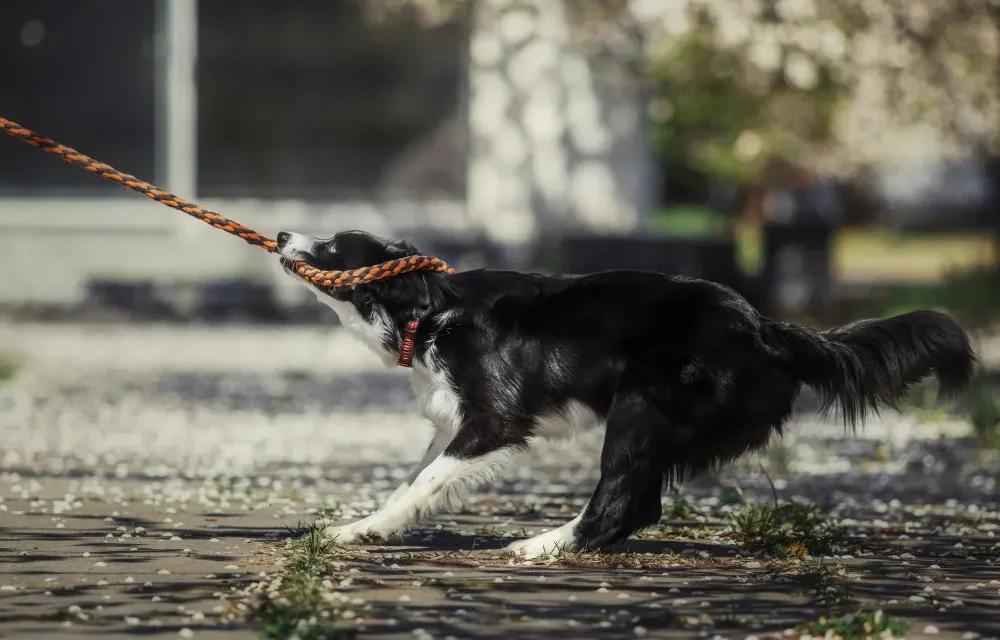Are you tired of your dog pulling you down the street like a runaway train every time you try to go for a walk?
It can be frustating exhausting, and even embarrassing when you’re constantly being dragged or struggling to keep control. You might wonder if there’s a better way to enjoy peaceful walks without all the tension and tugging.
One simple tip is to stop walking the moment your dog starts pulling, this teaches them that pulling doesn’t get them anywhere. However, a single techniques won’t help. You need to reward your dog when they walk calmly beside you. whith these there are common mistakes during teaching your dog to walk calmly on a lease.
In this blog, you’ll learn about why they matter, the best types of leashes, and how to choose the right one to make every walk a positive experience for you and your dog.
Why Is Leash Training a Dog Important?
Leash training isn’t just about control, it’s about communication and trust. When your dog walks calmly beside you, it shows respect for boundaries and signals that they feel safe. Well-trained leash manners allow your dog to explore the world while preventing dangerous situations like running into traffic or approaching aggressive dogs.
What You’ll Need to Get Started?
Before you begin, make sure you’re equipped with a few simple essentials:
- A well-fitted collar or harness
- A sturdy 4–6 ft leash (skip retractable ones for now)
- Tasty training treats (the kind your dog goes crazy for!)
- A calm, positive attitude, seriously, your energy matters
Pro tip: For dogs that tend to pull, a front-clip harness or no-pull harness can make a big difference.
How To Train Your Dog To Walk on a Leash?
1. Start in a Quiet, Familiar Environment
Leash training should start in a low-distraction location, such as your driveway, backyard, or living room. By doing this, your dog may concentrate better without being distracted by sounds, sights, or odors. Allowing them to become accustomed to strolling next to you in a relaxed environment is the aim. You can progressively introduce them to public areas once they feel comfortable in a controlled setting. Building trust and preventing setbacks are two benefits of starting slowly.
2. Introduce the Leash in a Positive Way
Allow your dog to wear the leash indoors for brief periods of time under supervision prior to the start of training walks. Give them praise and treats as you let them explore on the leash. This transforms the leash from something to be feared or resisted into a sign of positivity. At this point, it’s important to focus on comfort and familiarity rather than pulling or yanking the leash. A good start makes the training techniques go more smoothly.
3. Use a Clear Verbal Cue to Begin Walking
To indicate that walking has begun, choose a cue word such as “Let’s go,” “Walk,” or “Heel.” Give your dog a clear command and start walking; if they follow without tugging, give them a big pat on the back. To help your dog learn to associate the command with calm walking, be consistent with the cue. Your voice alone will eventually cause them to respond. This cue helps your dog know what’s expected of them right away.
4. Reward Calm Walking Behavior Frequently
During training walks, keep little, delicious snacks on hand and use them to give your dog a treat each time they walk well by your side. When the leash is loose and your dog is concentrating on you rather than tugging forward, that’s when you should treat them. To emotionally reinforce the conduct, give praise in a positive tone. Over time, your dog will associate calm walking with good outcomes. This makes it a habit to stroll with you stress-free.
5. Stop Moving If Your Dog Pulls
Progress shouldn’t be awarded for pulling on the leash. Stop walking and remain motionless if your dog begins to pull. Instead of pulling the leash, patiently wait for them to return the favor or to relax. Praise and keep walking when the leash relaxes. Your dog will learn from this that pulling will not help them.
6. Use the “Be a Tree” Method
Put your feet down and remain motionless like a tree if your dog keeps pulling after you’ve stopped. Refrain from moving forward until the dog lets go of the leash or comes back to you. Pulling won’t bring them where they want to go, according to this nonverbal cue. Reward them after they calm down and carry on. It’s a straightforward yet powerful method of discouraging pulling without resorting to punishment.
7. Practice “Change of Direction” Technique
Consider abruptly altering your walking direction when your dog becomes too eager or preoccupied. Gently get them to follow you while you move in the opposite direction. This method encourages them to pay attention to your motions and helps them refocus their attention on you. Because they must monitor you to know where you’re going, it also deters pulling. Reward them whenever they turn with you and remain near you.
8. Keep Training Sessions Short and Consistent
It can be frustrating for both of you to take long walks while exercising. Instead, try to get in several 5- to 10-minute training walks throughout the day. When your dog succeeds, always end on a good note and keep them constant. This maintains motivation while reinforcing learning. As your dog becomes better, you can gradually increase the amount of time you spend walking.
9. Gradually Introduce New Environments
Start introducing modest distractions, such as a stroll around the block or a visit to a peaceful park, if your dog is at ease strolling in calm areas. Work your way up to more crowded places with greater activity and noise. By exposing your dog gradually, you can save them from being overwhelmed. Before attempting again, step back and move to a more manageable environment if they have trouble in a new region. Always gain self-assurance at their own speed.
10. Stay Calm, Patient, and Encouraging
Training takes time, and tiny steps may lead to big gains. Steer clear of yelling, punishment, and frustration since these behaviors might cause your dog to become agitated and confused. Rather, remain composed, speak in a positive manner, and reward your dog with treats and praise. Appreciate little victories, such as taking a few steps with you without pulling. A well-behaved walking companion will reward your perseverance.
What To Do If Your Dog Pulls on the Leash?
If your dog pulls on the leash, the best thing to do is stop walking immediately. Don’t let them drag you forward, as this teaches them that pulling gets them where they want to go. Instead, stand still and wait until the leash loosens, then praise or reward them before continuing. You can also change direction to regain their focus and teach them to pay attention to your movements.
Use treats to reward calm walking and practice in quiet areas first before moving to busier places. Be consistent on every walk, and stay calm and patient, pulling is a common issue, but with time and positive reinforcement, your dog will learn to walk nicely by your side.
What is the best type of leash for your dog?
1. Standard Flat Leash (4 to 6 feet long):
This is the most common and versatile leash, perfect for everyday walks. Typically made from durable nylon or leather, it offers a good balance of control and freedom, allowing your dog to explore without pulling too far ahead. Its moderate length helps keep your dog close enough for safety but gives them some space to sniff and enjoy their surroundings.
2. No-Pull Harness with Front-Clip Leash:
For dogs that tend to pull, this combination is highly effective. The front-clip harness gently redirects your dog’s forward motion, making pulling uncomfortable without causing harm. It reduces strain on the neck and gives you better control, which makes walks more enjoyable and safer for both of you.
3. Leather Leash:
Leather leashes are known for their strength, durability, and comfort. They soften over time and offer a natural grip, reducing hand fatigue during long walks. They are especially good for larger or stronger dogs that might wear down nylon leashes quickly.
4. Nylon Leash:
Lightweight and easy to clean, nylon leashes are a practical and affordable choice. They come in a variety of colors and styles and work well for most dogs, especially smaller breeds. Nylon is also weather-resistant, making it a good all-around option.
5. Retractable Leash (Not Recommended for Training):
While retractable leashes allow your dog to roam farther, they often encourage pulling and reduce your control. They can be dangerous in crowded or busy areas because the thin cord can cause injury if it gets tangled or snapped. For dog training purposes, it’s best to avoid retractable leashes.
6. Slip Lead:
This is a simple loop leash that tightens when the dog pulls. It’s useful for quick control or training but should only be used by experienced handlers to avoid accidental choking or discomfort. It’s commonly used by trainers and in rescue situations.
7. Adjustable Leash:
These leashes allow you to change the length depending on the environment, for example, shortening it in busy areas and lengthening it in open spaces. This flexibility makes them a convenient choice for dog owners who walk in varied settings.
Common Mistakes to Avoid When Training Your Dog to Walk on a Leash
Training your dog to walk calmly on a leash can be challenging, and many dog owners unknowingly make mistakes that slow progress or even make pulling worse. One of the most common errors is using retractable leashes during training. While they may seem convenient, retractable leashes encourage dogs to pull because they give your dog more freedom to roam far ahead, making it harder for you to maintain control and teach good leash manners.
Another frequent mistake is yanking or pulling harshly on the leash in response to pulling. This can cause your dog discomfort or even pain, leading to fear, anxiety, or resistance to walking on a leash. Instead, gentle, consistent redirection paired with positive reinforcement is much more effective.
Additionally, some owners start training in highly distracting environments like busy streets or dog parks, which can overwhelm the dog and make it difficult for them to focus. It’s better to begin training in a calm, familiar area before gradually introducing distractions.
By recognizing and avoiding these common mistakes, you’ll set yourself and your dog up for successful, stress-free walks.




